North America is home to some of the most breathtaking natural landscapes on Earth, and nowhere is that more evident than in its national parks. From towering granite cliffs and alpine lakes to thundering waterfalls and ancient glaciers, the best national parks in the US and Canada offer a window into the continent’s wild and unspoiled soul.
These parks are more than just protected lands—they are places of wonder, refuge, and renewal. Whether you’re wandering through the snow-dusted peaks of Banff, hiking beneath the desert sun in Zion, or standing in awe of Yosemite’s granite giants, each destination tells a story as vast and varied as the terrain itself.
This guide takes you on a journey through ten of the best national parks in the US and Canada, celebrating not just their natural beauty, but the experiences, history, and cultural significance that make them extraordinary. With detailed insights, personal perspectives, and practical travel tips, you’ll discover how to experience these iconic places in ways that are immersive, respectful, and unforgettable.
So lace up your boots, charge your camera, and let’s begin an adventure through the wild heart of North America.
Table of Contents
1. Banff National Park (Canada)

Majestic Rocky Mountain Scenery
Banff National Park, located in the heart of Alberta’s Rockies, is a crown jewel among the best national parks in the US and Canada. Towering mountain peaks, pristine alpine meadows, and glacial valleys converge to form an iconic Canadian landscape that feels almost too majestic to be real. The scenery here isn’t just beautiful—it’s cinematic. Whether you’re standing at Bow Summit overlooking Peyto Lake or cruising the world-renowned Icefields Parkway, Banff seduces the senses with sweeping panoramas at every turn.
As Canada’s first national park, established in 1885, Banff carries not only natural significance but historical weight. Its rugged peaks and expansive wilderness were the starting point of Canada’s entire national park system, earning its place on any serious traveler’s list of the best national parks in the US and Canada.
Lake Louise and Moraine Lake
Two of the most photographed lakes in the world, Lake Louise and Moraine Lake, are nestled within Banff’s mountainous embrace. Lake Louise glows with a vibrant turquoise hue thanks to glacial silt suspended in its icy waters. Framed by the Victoria Glacier and Chateau Lake Louise, this is where elegance meets wildness.
Just a short drive away, Moraine Lake dazzles with a deeper blue set against the dramatic Valley of the Ten Peaks. Sunrise here is an almost spiritual experience, and the Rockpile Trail gives one of the best vantage points. For a serene morning, paddle a canoe across the glassy waters, watching reflections ripple beneath your oar.
These lakes are more than scenic highlights—they symbolize why Banff is consistently named among the best national parks in the US and Canada.
Outdoor Activities and Wildlife
What sets Banff apart is its perfect blend of wilderness and accessibility. Summer brings opportunities for hiking, biking, rock climbing, and kayaking. Trails like the Plain of Six Glaciers or Sunshine Meadows immerse hikers in alpine beauty, while Lake Minnewanka welcomes boaters and picnickers alike.
In winter, the park transforms into a snowy wonderland. Skiing at Lake Louise or Sunshine Village offers world-class slopes with jaw-dropping backdrops. Ice walks through Johnston Canyon and snowshoeing under frozen waterfalls are unforgettable seasonal activities.
Wildlife is part of the Banff experience. Elk, mountain goats, and even grizzlies roam freely. Spotting a herd of bighorn sheep or a lone wolf in the distance is not unusual—and it underscores why this park ranks among the most immersive and biologically diverse of the best national parks in the US and Canada.
2. Jasper National Park (Canada)
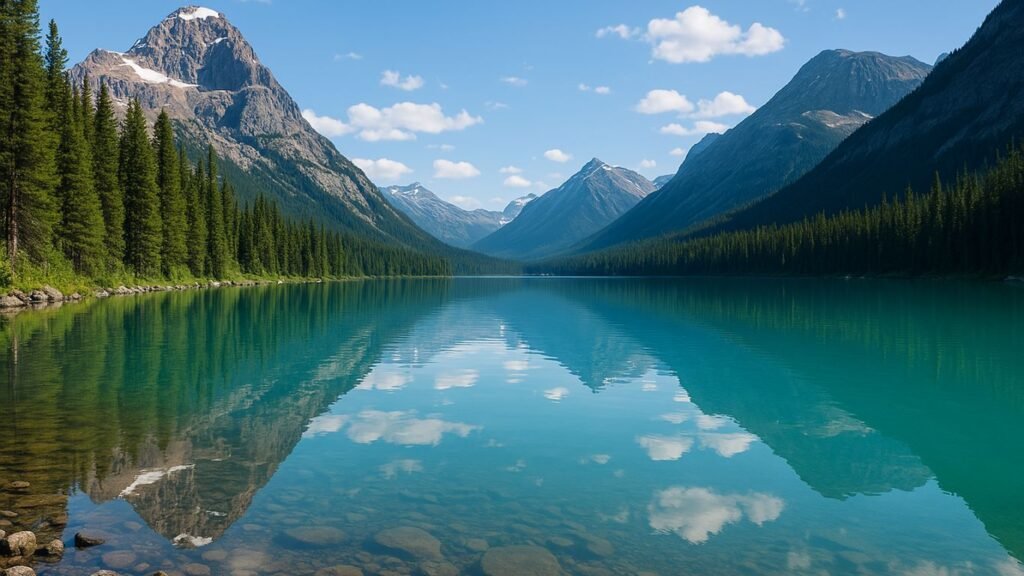
The Largest Dark Sky Preserve
Jasper National Park, located just north of Banff, holds its own as one of the best national parks in the US and Canada. This vast wilderness is home to the largest accessible Dark Sky Preserve on Earth, making it a premier destination for stargazers and astrophotographers. Whether you’re visiting during the annual Jasper Dark Sky Festival or simply lying on your back under the Milky Way, the celestial displays here are awe-inspiring.
Beyond the stars, Jasper’s dark sky status also protects its nocturnal wildlife and enhances the natural rhythm of the park’s ecosystem—just one of many reasons why it ranks among the best national parks in the US and Canada for both environmental stewardship and traveler experience.
Maligne Canyon and Medicine Lake
Maligne Canyon is a geological marvel carved deep into the limestone bedrock. Its narrow chasms and waterfalls are accessible via a series of bridges, each revealing dramatic views of rushing water and sculpted rock walls. It’s a short walk that feels like stepping into a natural cathedral.
Further along the scenic Maligne Lake Road, you’ll find Medicine Lake—known for its fascinating hydrology. Every summer, the lake seems to mysteriously drain away, only to return with spring’s thaw. This illusion of disappearance is caused by an underground cave system, adding an air of mystery to one of the best national parks in the US and Canada.
These two landmarks reflect Jasper’s unique blend of beauty and intrigue—perfect for travelers seeking something beyond the ordinary.
Athabasca Falls and Glaciers
Athabasca Falls offers a spectacle of raw power. Despite its modest height, the sheer volume of water crashing through a narrow gorge creates an unforgettable roar. The falls are easily accessible from the main road, making them a must-stop even for casual visitors.
Jasper is also the gateway to the Columbia Icefield, one of the largest non-polar icefields in the world. Here, the Athabasca Glacier stretches down to within walking distance of the highway. Guided tours let visitors walk on ancient ice or board specially designed Ice Explorers for a surreal journey across the glacier’s surface.
Whether you come for the stargazing, waterfalls, or frozen wonders, Jasper stands tall among the best national parks in the US and Canada—offering pristine adventure with a sense of deep, natural silence.
3. Glacier National Park (USA)
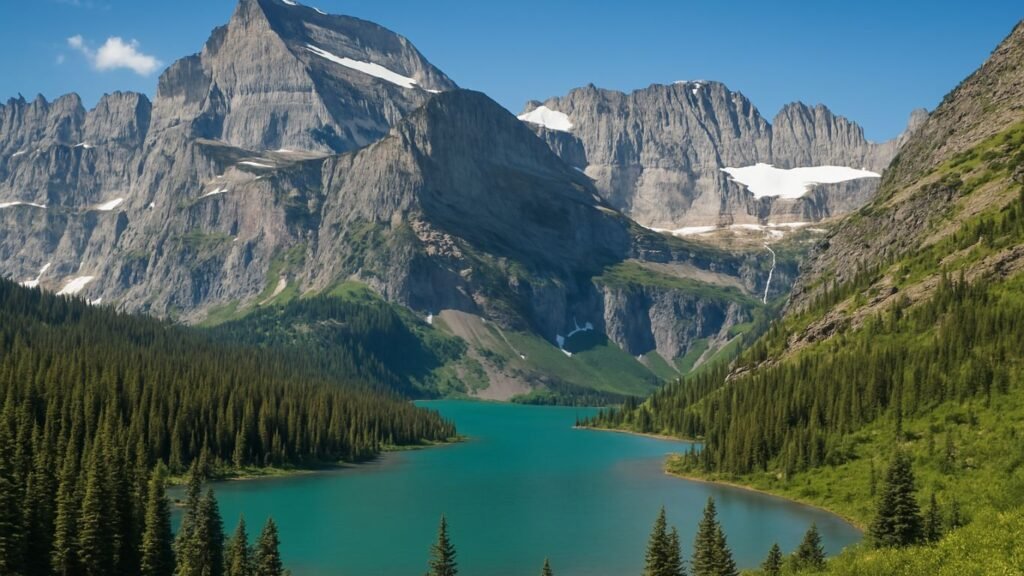
Going-to-the-Sun Road
Glacier National Park, tucked along Montana’s northern border, is a masterpiece of mountain scenery and alpine wilderness—an undeniable standout among the best national parks in the US and Canada. One of its most iconic features is the Going-to-the-Sun Road. Spanning 50 miles through the heart of the park, this engineering marvel winds across the Continental Divide and offers one of the most scenic drives in the world.
From the glacially-carved valleys to the dramatic drop-offs and tunnel views, the road is more than transportation—it’s a journey through ancient geology and living beauty. Every curve opens to panoramic vistas that remind visitors why Glacier belongs on every list of the best national parks in the US and Canada.
Grinnell Glacier and Hiking Trails
For those who prefer boots over wheels, Glacier delivers an extraordinary hiking experience. Grinnell Glacier Trail is a top-tier trek that rewards effort with close-up views of one of the park’s most accessible glaciers. Along the way, hikers pass turquoise lakes, alpine meadows, and possibly even mountain goats or moose.
The park features over 700 miles of trails, ranging from gentle lakeside strolls to strenuous backcountry routes. The Highline Trail, for example, runs along a cliff edge and offers an unforgettable perspective of the rugged wilderness. These immersive hikes reinforce Glacier’s place among the best national parks in the US and Canada, especially for those seeking a personal connection with nature.
Diverse Wildlife Encounters
Glacier’s ecosystem is a vital corridor for wildlife. It’s one of the few places in the contiguous United States where all native carnivores still roam—including grizzly bears, mountain lions, and wolves. Visitors also have a chance to see bighorn sheep, marmots, and the ever-charismatic pika.
Birdwatchers and photographers flock here to witness everything from bald eagles to rare harlequin ducks. The sheer biodiversity within the park’s boundaries is another reason it ranks among the best national parks in the US and Canada, offering a wild, unfiltered glimpse into nature’s rhythms.
4. Yellowstone National Park (USA)
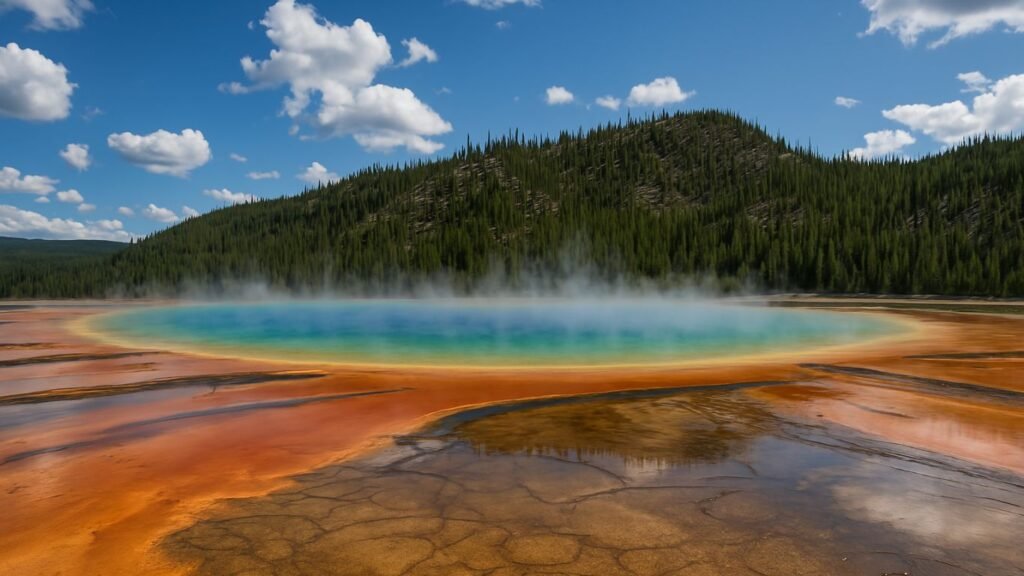
Geothermal Features and Old Faithful
Yellowstone National Park is not just historic—it’s foundational. As the world’s first national park, established in 1872, it laid the groundwork for conservation efforts that inspired the global park movement. Today, it remains one of the best national parks in the US and Canada, largely due to its surreal geothermal landscape.
Old Faithful is the star of the show. This legendary geyser erupts like clockwork, shooting superheated water up to 180 feet into the air every 90 minutes. But it’s just the beginning—Yellowstone features over 10,000 hydrothermal features, including colorful hot springs like Grand Prismatic Spring and bubbling mud pots that make the earth feel very much alive.
These otherworldly formations aren’t just stunning—they’re reminders of the supervolcano lurking beneath Yellowstone’s surface, adding a layer of geologic intrigue to one of the most iconic and fascinating of the best national parks in the US and Canada.
Grand Canyon of the Yellowstone
Carved by the Yellowstone River over thousands of years, the Grand Canyon of the Yellowstone is a riot of color and power. Rusty red and golden rock walls contrast dramatically with the bright blue river and the white thunder of Lower Falls, which plunges more than 300 feet—twice the height of Niagara Falls.
Artist Point is the most famous viewpoint, but both the North and South Rim trails offer multiple perspectives of the canyon’s rugged grandeur. These stunning vistas, layered with history and geology, help Yellowstone maintain its rightful status as one of the best national parks in the US and Canada.
Bison, Wolves, and Bears
Yellowstone is also North America’s safari. Nowhere else in the continental U.S. offers the same density of large wildlife in such an accessible setting. The Lamar and Hayden Valleys are prime viewing spots, often referred to as “the American Serengeti.” You’ll likely encounter vast herds of bison, elk grazing near thermal basins, and—if you’re lucky—a grizzly bear lumbering through a meadow.
Reintroduced in the 1990s, wolves have also rebalanced Yellowstone’s ecosystem, a powerful example of how conservation can restore natural harmony. For wildlife lovers, this park is unmatched among the best national parks in the US and Canada.
5. Grand Teton National Park (USA)
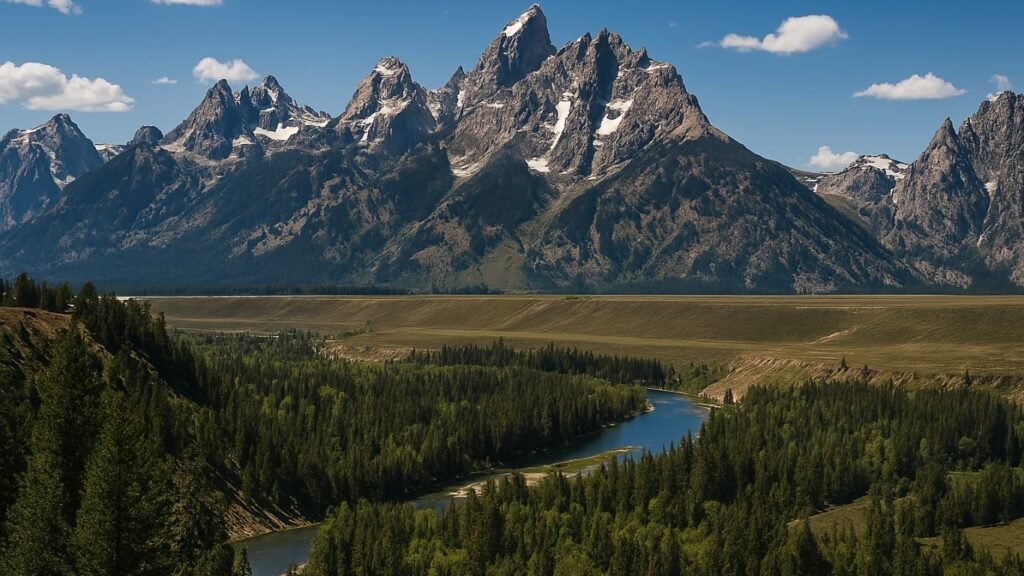
The Teton Mountain Range
Grand Teton National Park, just south of Yellowstone, stands as a masterpiece of rugged elegance. The park’s namesake range, the Tetons, rise abruptly from the Jackson Hole valley, creating one of the most striking skylines among the best national parks in the US and Canada. Grand Teton, the highest peak at 13,775 feet, looms like a sentinel over alpine lakes and evergreen forests.
What sets the Tetons apart is their raw, jagged profile. Unlike many other ranges softened by erosion, the Tetons are young in geological terms—sharp, angular, and bold. At sunrise or dusk, the peaks glow in hues of gold and pink, captivating photographers, hikers, and dreamers alike. Their dramatic appearance alone earns Grand Teton a firm place among the best national parks in the US and Canada.
Jenny Lake and Hiking
Jenny Lake is the park’s centerpiece and a portal to some of its most iconic hikes. Visitors can take a shuttle boat across the lake or walk along its scenic shore before ascending to Hidden Falls or Inspiration Point. The crystal-clear waters reflect the Tetons like a mirror, creating a moment that feels lifted from a painting.
For more ambitious hikers, the Cascade Canyon and Paintbrush Canyon trails wind through meadows of wildflowers, across creeks, and beneath glaciers. These hikes are where you begin to feel the untamed soul of one of the best national parks in the US and Canada, where every bend in the trail delivers solitude and splendor.
Snake River and Scenic Views
The Snake River flows through the heart of the park, adding another layer of natural drama. It’s famously featured in Ansel Adams’ photography, and today, you can experience it via raft, kayak, or a quiet riverside walk. Oxbow Bend, in particular, is a beloved viewpoint where the calm water reflects Mount Moran—a perfect photo op, especially in early morning light.
Whether you come to paddle, hike, photograph, or simply breathe deeply, Grand Teton offers a level of serenity and grandeur that defines the best national parks in the US and Canada.
6. Zion National Park (USA)
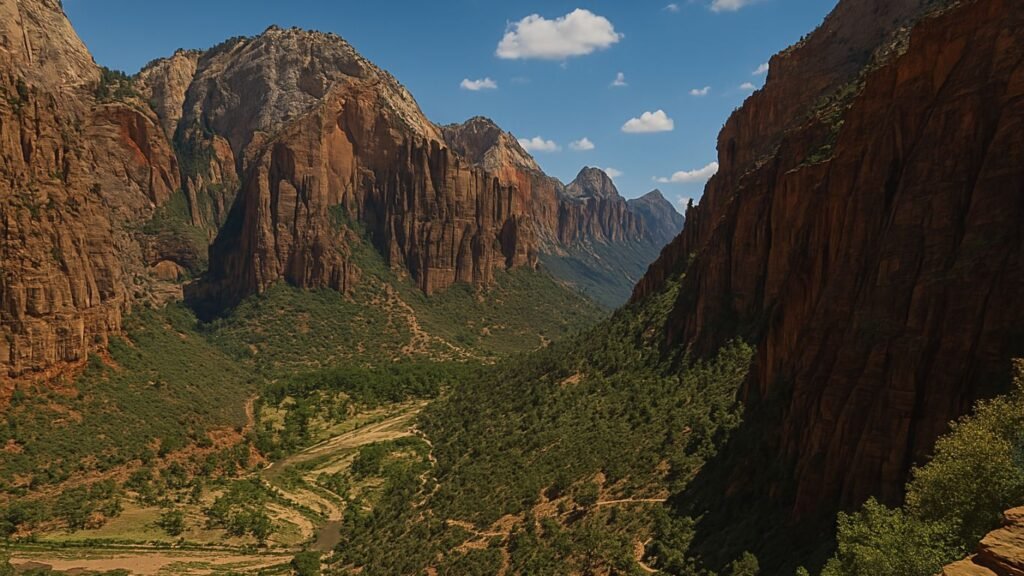
The Narrows and Angels Landing
Zion National Park in southern Utah delivers raw desert drama on a grand scale. Towering sandstone cliffs, narrow slot canyons, and vividly colored rock layers make it a visual masterpiece—one of the most unique among the best national parks in the US and Canada. Two of Zion’s most iconic hikes offer experiences that range from spiritual to exhilarating.
The Narrows is a river hike like no other. Wading through the Virgin River between 1,000-foot canyon walls, you feel dwarfed by time and water. It’s a serene yet humbling experience that immerses you in the essence of Zion’s sculpted landscape.
On the other end of the spectrum is Angels Landing—a heart-pounding climb along a narrow ridge with sheer drop-offs on both sides. While not for the faint of heart, the payoff is a 360-degree view over Zion Canyon that reaffirms the park’s place among the best national parks in the US and Canada.
Emerald Pools and Canyon Overlooks
For something more moderate, the Emerald Pools offer a layered hike past tranquil waterfalls and lush oases. The combination of greenery against the desert stone creates a sensory contrast that is emblematic of Zion’s varied terrain.
Canyon Overlook Trail, although short, delivers astonishing views with minimal effort. Observation Point and the East Rim Trail offer higher elevations and quieter paths, perfect for those wanting to escape the crowds while still enjoying some of the best national parks in the US and Canada scenery.
Unique Desert Ecosystem
Zion’s beauty lies not only in its scenery but also in its ecological diversity. At the intersection of the Colorado Plateau, Great Basin, and Mojave Desert, Zion hosts an astonishing variety of plant and animal life. From hanging gardens in the canyon walls to bighorn sheep navigating steep cliffs, life here thrives in ways that seem improbable.
It’s this juxtaposition—harsh landscape with rich biodiversity—that makes Zion more than just beautiful. It’s why it continues to earn its place among the best national parks in the US and Canada, drawing in adventurers, nature lovers, and seekers of the extraordinary.
7. Bryce Canyon National Park (USA)
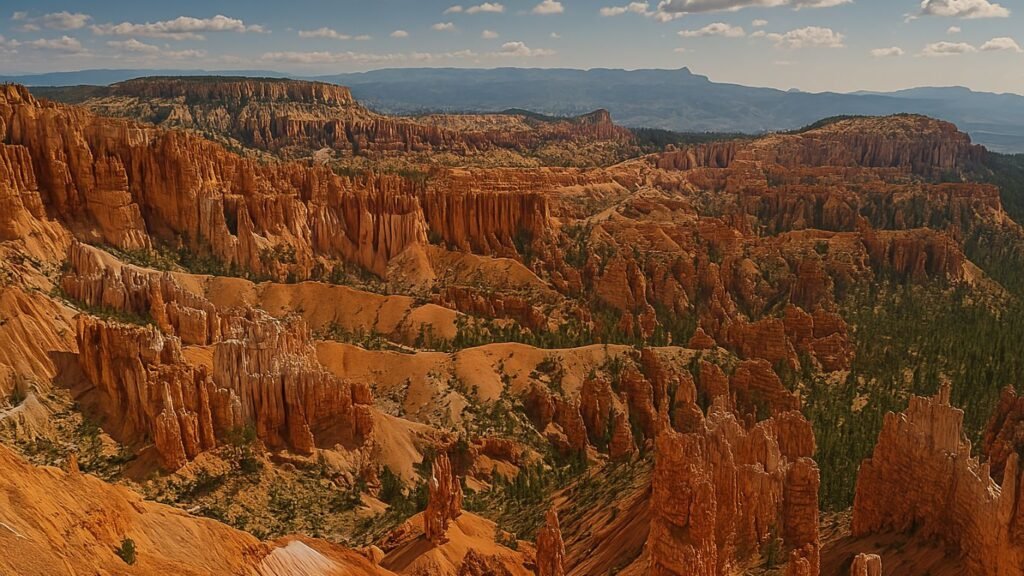
Hoodoos and Amphitheaters
Bryce Canyon National Park is unlike any other. Known for its surreal landscape of hoodoos—tall, thin spires of eroded rock—it presents a visual experience so unique it almost defies belief. These natural sculptures cluster in vast amphitheaters, most notably the Bryce Amphitheater, where sunrise and sunset turn stone into fire. This geological wonder cements Bryce Canyon as one of the best national parks in the US and Canada, offering a dreamscape that feels more Martian than earthly.
What makes Bryce even more remarkable is how approachable its drama is. Scenic viewpoints are just steps from the parking lots, making these incredible formations accessible to every type of traveler—from photographers to families to solo wanderers.
Navajo Loop and Queen’s Garden Trail
For those looking to explore the canyon from below, the Navajo Loop and Queen’s Garden Trail is the quintessential hike. This moderate loop winds down among the hoodoos, offering a ground-level perspective that reveals their true size and intricacy.
Along the trail, you’ll pass Thor’s Hammer and Wall Street—narrow corridors flanked by stone skyscrapers. The silence is deep, and the scale is intimate. It’s one of the most memorable hiking experiences among the best national parks in the US and Canada, delivering both adventure and a profound sense of connection to the Earth’s erosive power.
Stargazing Opportunities
Bryce Canyon’s night sky is nearly as impressive as its daytime views. At 8,000 feet elevation and with minimal light pollution, the park is a designated Dark Sky Sanctuary. On a clear night, the Milky Way sweeps across the sky like a silver ribbon, and thousands of stars seem to flicker in celebration.
The park regularly hosts astronomy programs where rangers and volunteer astronomers help visitors explore constellations, planets, and even distant galaxies. This cosmic dimension adds yet another reason Bryce ranks high among the best national parks in the US and Canada—offering wonder both above and below the horizon.
8. Yosemite National Park (USA)
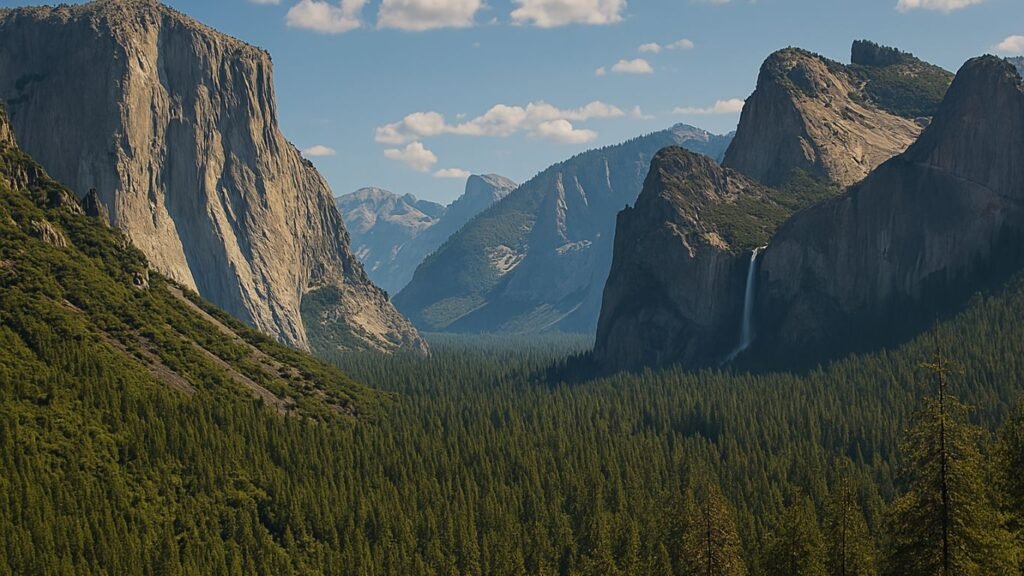
Iconic Landmarks: El Capitan and Half Dome
Yosemite National Park is more than a destination—it’s a legend. Nestled in California’s Sierra Nevada, it has inspired generations of naturalists, climbers, and artists. At its core are two of the most recognizable landmarks in all of the best national parks in the US and Canada: El Capitan and Half Dome.
El Capitan towers more than 3,000 feet above the valley floor and remains one of the most iconic rock faces in the world. For rock climbers, it’s the ultimate challenge. Just across the valley, Half Dome offers an equally legendary profile. Its cable route draws thousands of hikers each season, and the view from the summit is a soul-stirring reward.
These granite monoliths are not just symbols of Yosemite—they define its epic character and secure its position among the best national parks in the US and Canada.
Yosemite Valley and Waterfalls
The granite-carved Yosemite Valley is the heart of the park, home to some of its most beloved features. In spring and early summer, Yosemite Falls—the tallest waterfall in North America—thunders with snowmelt. Nearby, Bridalveil Fall and Vernal Fall offer elegant counterpoints, while misty spray creates prismatic magic for hikers who venture close.
Tunnel View, one of the most famous scenic overlooks, presents an unforgettable panorama of the entire valley. Here, you understand why Yosemite holds its place among the best national parks in the US and Canada—every vista seems designed to awaken awe.
Giant Sequoia Groves
Beyond the granite cliffs and rushing waterfalls lie the ancient groves of giant sequoias—some of the oldest and largest living organisms on Earth. The Mariposa Grove, near the park’s southern entrance, is home to over 500 mature sequoias, including the Grizzly Giant and the Faithful Couple.
Walking among these towering trees is a profoundly humbling experience. Their size, age, and silent presence tell stories of millennia gone by. In a park already filled with natural marvels, these groves elevate Yosemite even further among the best national parks in the US and Canada, offering a living connection to Earth’s deep past.
9. Acadia National Park (USA)
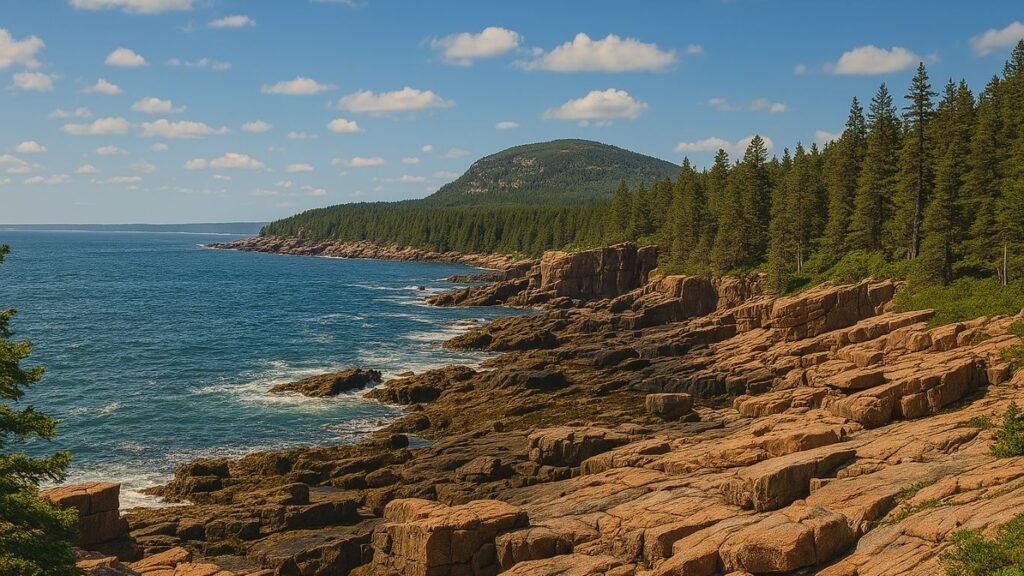
Coastal Landscapes and Cadillac Mountain
Acadia National Park, perched on the rugged coast of Maine, offers a refreshing contrast to the mountainous inland parks. Its granite peaks meet the Atlantic Ocean in a wild, weather-beaten embrace, creating a coastal haven that easily ranks among the best national parks in the US and Canada.
Cadillac Mountain is Acadia’s crown jewel. For part of the year, its summit is the first place in the United States to see the sunrise. Whether you hike to the top via North Ridge Trail or drive up the winding access road, the panoramic views of ocean, islands, and pine forest are breathtaking—especially when bathed in dawn’s golden light.
This unique ocean-meets-mountains landscape is what sets Acadia apart and secures its place among the most memorable and diverse of the best national parks in the US and Canada.
Carriage Roads and Hiking Trails
John D. Rockefeller Jr. personally funded and oversaw the construction of Acadia’s 45 miles of rustic carriage roads. These beautifully crafted, car-free routes are ideal for biking, walking, and horseback riding. Graceful stone bridges and forested paths make for an experience that feels both tranquil and timeless.
Beyond the carriage roads, Acadia offers more than 150 miles of hiking trails. From the adrenaline-pumping Precipice Trail to the serene Ocean Path, every route reveals new aspects of the park’s rocky coastline and inland forests. This blend of accessibility and adventure reinforces why Acadia is firmly among the best national parks in the US and Canada.
Bar Harbor and Local Charm
No visit to Acadia is complete without exploring Bar Harbor, the charming coastal town on Mount Desert Island. This harborfront village is filled with seafood restaurants, boutiques, and New England character. After a long day on the trails, there’s nothing quite like a lobster dinner followed by a stroll along the Shore Path as the sun dips below the horizon.
Bar Harbor offers the perfect gateway to Acadia—an ideal combination of nature and culture that’s rare even among the best national parks in the US and Canada. Here, the natural and human worlds blend seamlessly, creating a travel experience that feels both grounded and elevated.
10. Kenai Fjords National Park (USA)
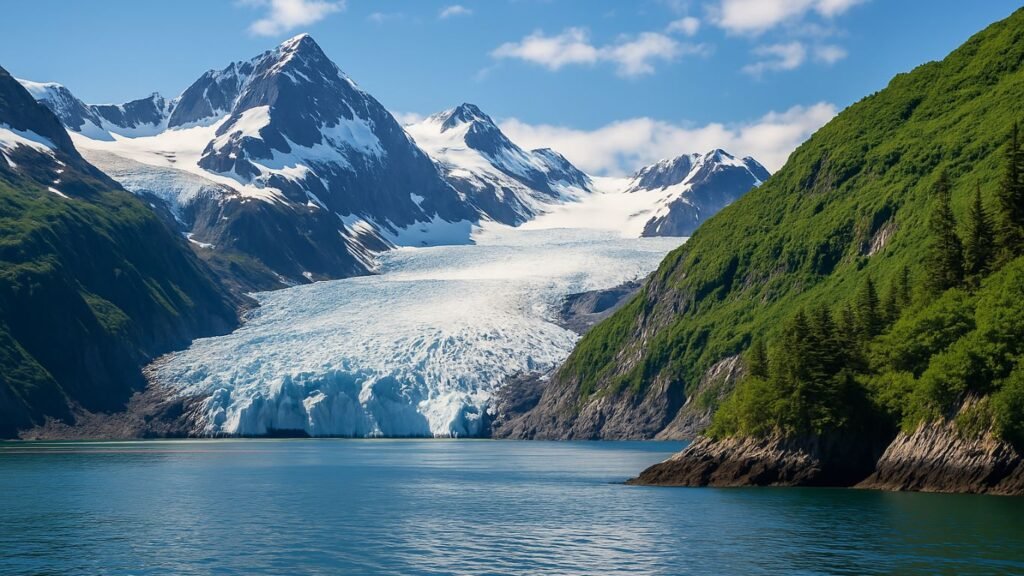
Glaciers and Marine Wildlife
Kenai Fjords National Park, located on Alaska’s southern coast, is a frozen frontier where ice, ocean, and wildlife collide in spectacular fashion. With over 50% of the park covered in ice, it’s a glacial wonderland that earns its spot among the best national parks in the US and Canada. Towering tidewater glaciers flow directly into fjords, shedding icebergs with a thunderous roar and creating a landscape as dramatic as it is pristine.
Wildlife thrives in this harsh, beautiful environment. Humpback whales breach in Resurrection Bay, puffins dive for fish, and harbor seals rest on floating ice. Orcas glide through narrow channels, while mountain goats cling to cliffs above. The ecosystem is rich, untamed, and entirely unforgettable—Kenai’s raw power and ecological vitality help secure its place among the best national parks in the US and Canada.
Boat Tours and Kayaking
Accessing the park’s dramatic coastline is best done by water. Boat tours departing from Seward bring visitors face-to-face with calving glaciers, sea otters playing in kelp beds, and colonies of seabirds clinging to cliffside rookeries. These tours offer not just sightseeing, but intimate engagement with a landscape that feels completely removed from the modern world.
For a closer, quieter encounter, sea kayaking offers an immersive journey. Paddling through icy inlets, visitors can explore hidden coves and untouched beaches, making it one of the most rewarding experiences available in the best national parks in the US and Canada. Few adventures rival the serenity of floating beside a blue glacier under the midnight sun.
Harding Icefield
The Harding Icefield is one of the park’s greatest treasures—and one of North America’s largest remaining ice masses. Accessible via a strenuous but spectacular trail from Exit Glacier, the view from the top opens to a shimmering white horizon that stretches for miles.
This ancient sheet of ice is a remnant of the Pleistocene Epoch, a living relic that continues to shape the fjords below. Standing at its edge, surrounded by silence and snow, is one of the most humbling moments you can have in any of the best national parks in the US and Canada.
Conclusion
Embracing the Natural Beauty
The best national parks in the US and Canada are more than scenic destinations—they’re sacred spaces where nature’s artistry is on full display. From the icy fjords of Alaska to the red rock cliffs of Utah, these parks span a spectrum of landscapes and ecosystems that defy easy comparison. What unites them is their ability to evoke wonder, humility, and a renewed connection with the wild.
Each park tells its own story. Whether you’re marveling at the age-old sequoias of Yosemite, standing beneath the northern lights in Jasper, or kayaking past a glacier in Kenai Fjords, you’re not just seeing the world—you’re feeling it.
In a time when noise and speed dominate daily life, these parks offer a necessary pause. A place to breathe, reflect, and remember what it means to be small in a vast and beautiful world.
Creating Lasting Memories
Visiting the best national parks in the US and Canada isn’t just a vacation—it’s an experience that lingers. The sound of a waterfall echoing through a canyon. The hush of snowfall in a pine forest. The collective gasp as Old Faithful erupts against a cobalt sky. These are memories not measured in miles, but in meaning.
Whether you’re a first-time visitor or a seasoned park explorer, each trip offers a new perspective, a deeper insight, and a fresh reason to return. These places invite us to explore, to protect, and to carry their beauty forward in how we live.
In the end, the best national parks in the US and Canada do more than just wow us—they change us. And that’s their greatest gift of all.
FAQ
Q: What are the best national parks in the US and Canada for first-time visitors?
A: Yosemite, Banff, Yellowstone, and Acadia are ideal for first-time visitors. They offer accessible trails, iconic scenery, and well-developed infrastructure that make exploring easy without compromising on adventure.
Q: When is the best time to visit these parks?
A: Late spring (May–June) and early fall (September–October) are the best times to visit. You’ll enjoy mild weather, fewer crowds, and stunning seasonal scenery across the best national parks in the US and Canada.
Q: Do I need reservations for national parks?
A: Yes, some popular parks require reservations for timed entry, specific trails, or campsites—especially during peak season. Always check the official National Park Service or Parks Canada websites before your trip.
Q: Can I visit multiple parks in one trip?
A: Absolutely. Many travelers combine parks like Banff and Jasper or Yellowstone and Grand Teton. Just be sure to plan your route carefully and allow enough time at each stop to truly enjoy these natural wonders.
Q: Are pets allowed in national parks?
A: Most parks allow pets in designated areas but restrict them from hiking trails or backcountry zones to protect wildlife. Research pet policies in advance and never leave animals unattended in vehicles.
